Annotated Bibliography: Analyzing Supply and Demand in Economics
VerifiedAdded on 2020/03/13
|5
|1070
|67
Annotated Bibliography
AI Summary
This annotated bibliography examines the relationship between supply, demand, and price in economics. It synthesizes research from multiple sources, including studies on optimal inventory policies, the basics of supply and demand, optimized control of price-based demand response, demand response and smart grids, and convergence of volatile power markets with price-based demand response. The bibliography explores how factors such as consumer purchasing power, fashion trends, population growth, and market expansion influence product demand and price variance. It also highlights the impact of supply and demand on consumer surplus, market equilibrium, and the effects of income on consumer choices. The research underscores the importance of price in shaping consumer behavior and market dynamics, offering a comprehensive overview of key economic concepts.
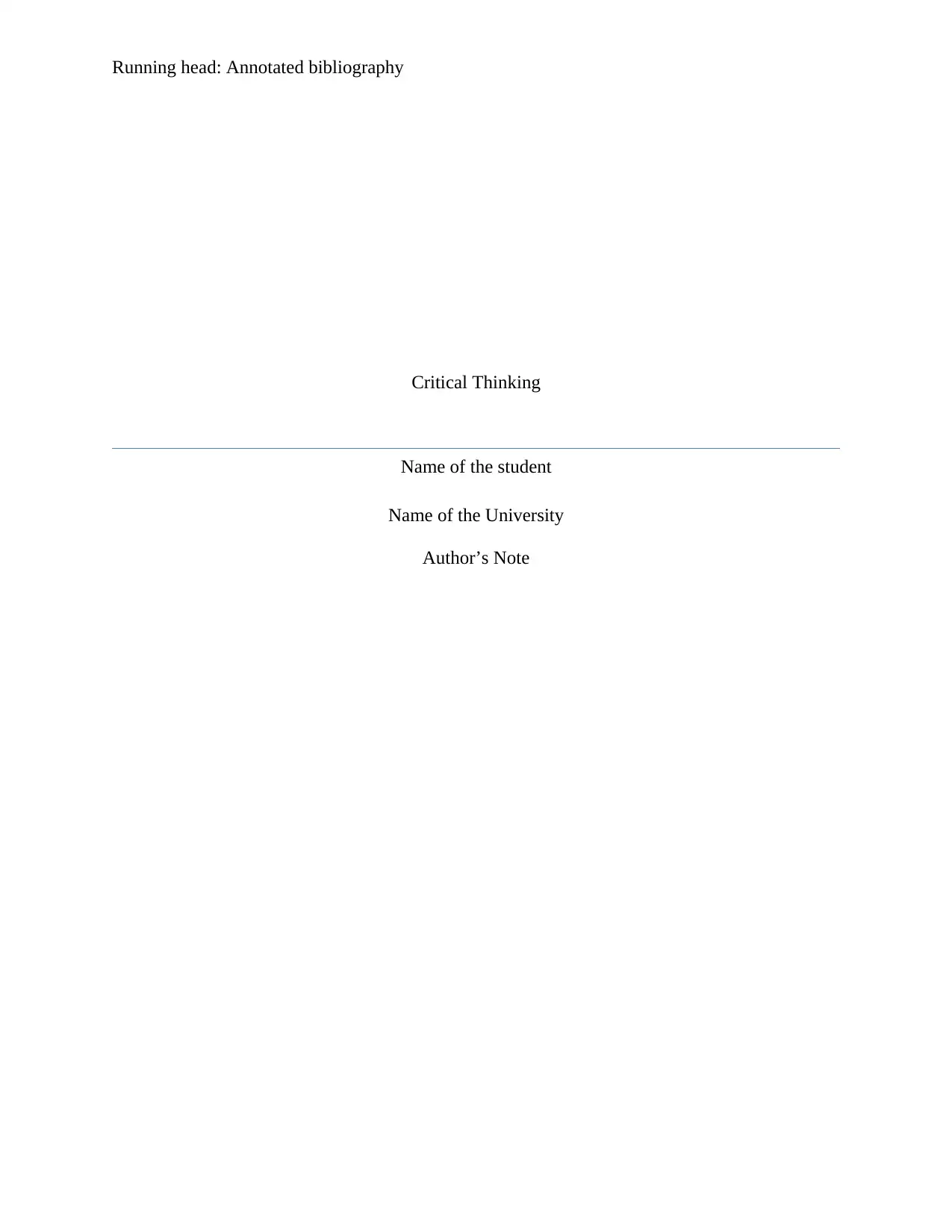
Running head: Annotated bibliography
Critical Thinking
Name of the student
Name of the University
Author’s Note
Critical Thinking
Name of the student
Name of the University
Author’s Note
Paraphrase This Document
Need a fresh take? Get an instant paraphrase of this document with our AI Paraphraser
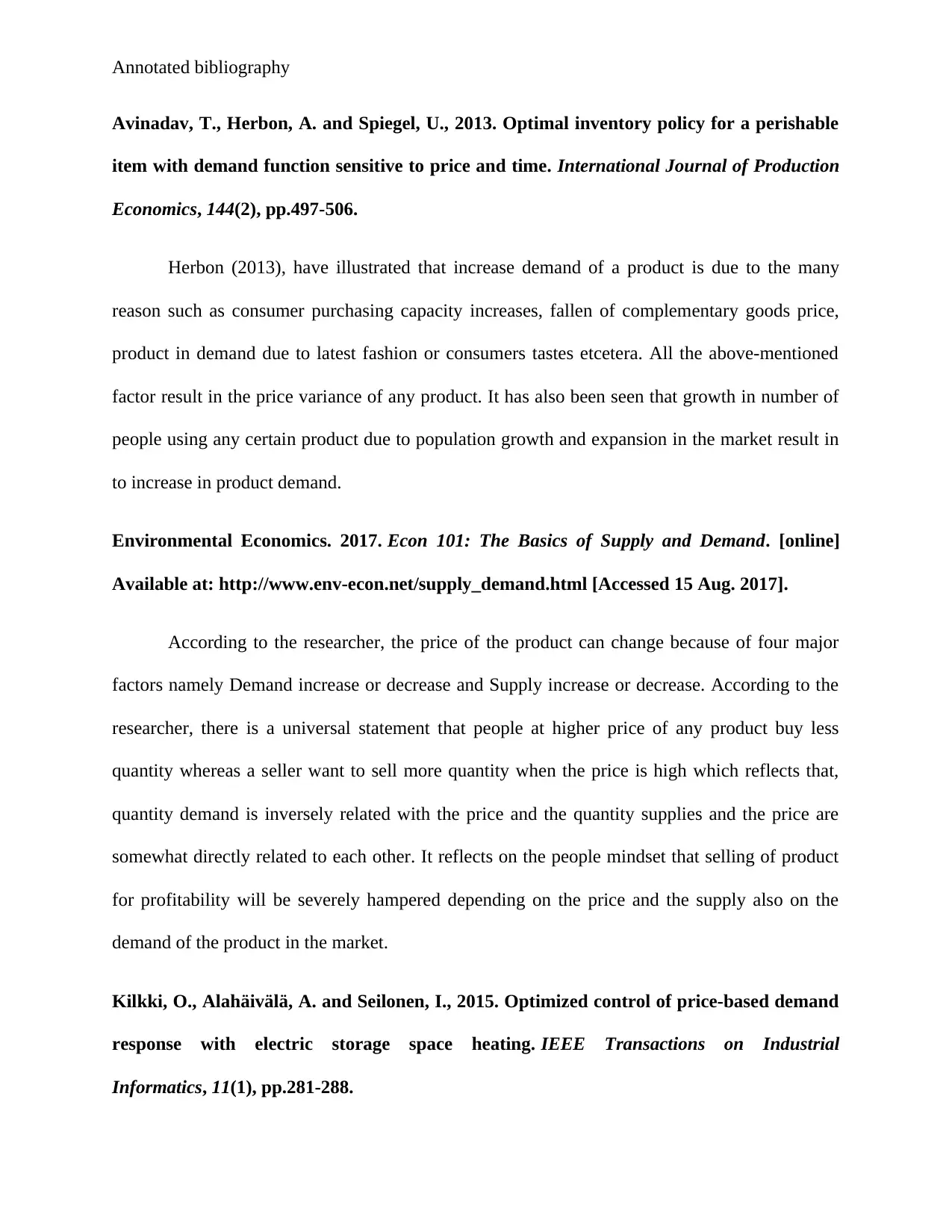
Annotated bibliography
Avinadav, T., Herbon, A. and Spiegel, U., 2013. Optimal inventory policy for a perishable
item with demand function sensitive to price and time. International Journal of Production
Economics, 144(2), pp.497-506.
Herbon (2013), have illustrated that increase demand of a product is due to the many
reason such as consumer purchasing capacity increases, fallen of complementary goods price,
product in demand due to latest fashion or consumers tastes etcetera. All the above-mentioned
factor result in the price variance of any product. It has also been seen that growth in number of
people using any certain product due to population growth and expansion in the market result in
to increase in product demand.
Environmental Economics. 2017. Econ 101: The Basics of Supply and Demand. [online]
Available at: http://www.env-econ.net/supply_demand.html [Accessed 15 Aug. 2017].
According to the researcher, the price of the product can change because of four major
factors namely Demand increase or decrease and Supply increase or decrease. According to the
researcher, there is a universal statement that people at higher price of any product buy less
quantity whereas a seller want to sell more quantity when the price is high which reflects that,
quantity demand is inversely related with the price and the quantity supplies and the price are
somewhat directly related to each other. It reflects on the people mindset that selling of product
for profitability will be severely hampered depending on the price and the supply also on the
demand of the product in the market.
Kilkki, O., Alahäivälä, A. and Seilonen, I., 2015. Optimized control of price-based demand
response with electric storage space heating. IEEE Transactions on Industrial
Informatics, 11(1), pp.281-288.
Avinadav, T., Herbon, A. and Spiegel, U., 2013. Optimal inventory policy for a perishable
item with demand function sensitive to price and time. International Journal of Production
Economics, 144(2), pp.497-506.
Herbon (2013), have illustrated that increase demand of a product is due to the many
reason such as consumer purchasing capacity increases, fallen of complementary goods price,
product in demand due to latest fashion or consumers tastes etcetera. All the above-mentioned
factor result in the price variance of any product. It has also been seen that growth in number of
people using any certain product due to population growth and expansion in the market result in
to increase in product demand.
Environmental Economics. 2017. Econ 101: The Basics of Supply and Demand. [online]
Available at: http://www.env-econ.net/supply_demand.html [Accessed 15 Aug. 2017].
According to the researcher, the price of the product can change because of four major
factors namely Demand increase or decrease and Supply increase or decrease. According to the
researcher, there is a universal statement that people at higher price of any product buy less
quantity whereas a seller want to sell more quantity when the price is high which reflects that,
quantity demand is inversely related with the price and the quantity supplies and the price are
somewhat directly related to each other. It reflects on the people mindset that selling of product
for profitability will be severely hampered depending on the price and the supply also on the
demand of the product in the market.
Kilkki, O., Alahäivälä, A. and Seilonen, I., 2015. Optimized control of price-based demand
response with electric storage space heating. IEEE Transactions on Industrial
Informatics, 11(1), pp.281-288.
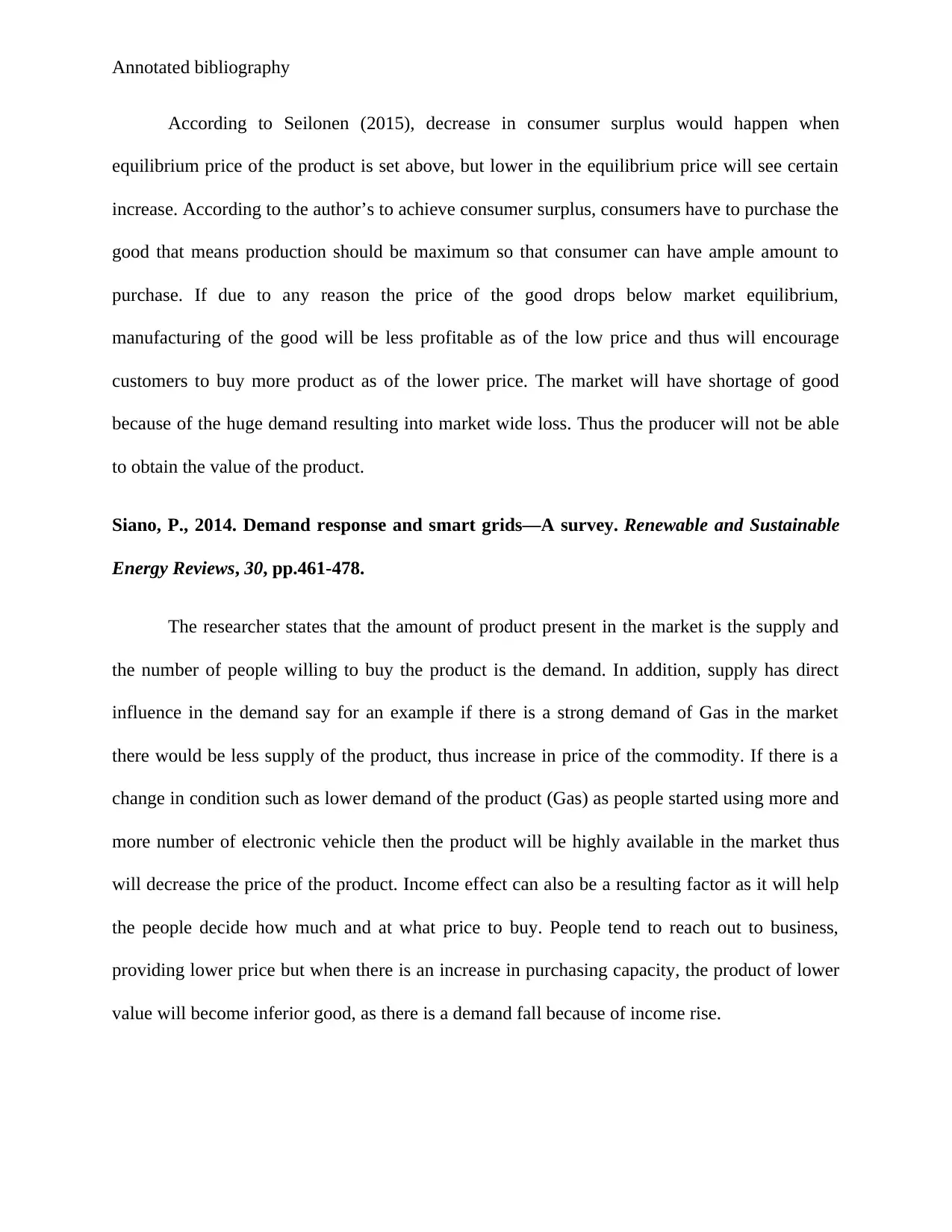
Annotated bibliography
According to Seilonen (2015), decrease in consumer surplus would happen when
equilibrium price of the product is set above, but lower in the equilibrium price will see certain
increase. According to the author’s to achieve consumer surplus, consumers have to purchase the
good that means production should be maximum so that consumer can have ample amount to
purchase. If due to any reason the price of the good drops below market equilibrium,
manufacturing of the good will be less profitable as of the low price and thus will encourage
customers to buy more product as of the lower price. The market will have shortage of good
because of the huge demand resulting into market wide loss. Thus the producer will not be able
to obtain the value of the product.
Siano, P., 2014. Demand response and smart grids—A survey. Renewable and Sustainable
Energy Reviews, 30, pp.461-478.
The researcher states that the amount of product present in the market is the supply and
the number of people willing to buy the product is the demand. In addition, supply has direct
influence in the demand say for an example if there is a strong demand of Gas in the market
there would be less supply of the product, thus increase in price of the commodity. If there is a
change in condition such as lower demand of the product (Gas) as people started using more and
more number of electronic vehicle then the product will be highly available in the market thus
will decrease the price of the product. Income effect can also be a resulting factor as it will help
the people decide how much and at what price to buy. People tend to reach out to business,
providing lower price but when there is an increase in purchasing capacity, the product of lower
value will become inferior good, as there is a demand fall because of income rise.
According to Seilonen (2015), decrease in consumer surplus would happen when
equilibrium price of the product is set above, but lower in the equilibrium price will see certain
increase. According to the author’s to achieve consumer surplus, consumers have to purchase the
good that means production should be maximum so that consumer can have ample amount to
purchase. If due to any reason the price of the good drops below market equilibrium,
manufacturing of the good will be less profitable as of the low price and thus will encourage
customers to buy more product as of the lower price. The market will have shortage of good
because of the huge demand resulting into market wide loss. Thus the producer will not be able
to obtain the value of the product.
Siano, P., 2014. Demand response and smart grids—A survey. Renewable and Sustainable
Energy Reviews, 30, pp.461-478.
The researcher states that the amount of product present in the market is the supply and
the number of people willing to buy the product is the demand. In addition, supply has direct
influence in the demand say for an example if there is a strong demand of Gas in the market
there would be less supply of the product, thus increase in price of the commodity. If there is a
change in condition such as lower demand of the product (Gas) as people started using more and
more number of electronic vehicle then the product will be highly available in the market thus
will decrease the price of the product. Income effect can also be a resulting factor as it will help
the people decide how much and at what price to buy. People tend to reach out to business,
providing lower price but when there is an increase in purchasing capacity, the product of lower
value will become inferior good, as there is a demand fall because of income rise.
⊘ This is a preview!⊘
Do you want full access?
Subscribe today to unlock all pages.

Trusted by 1+ million students worldwide
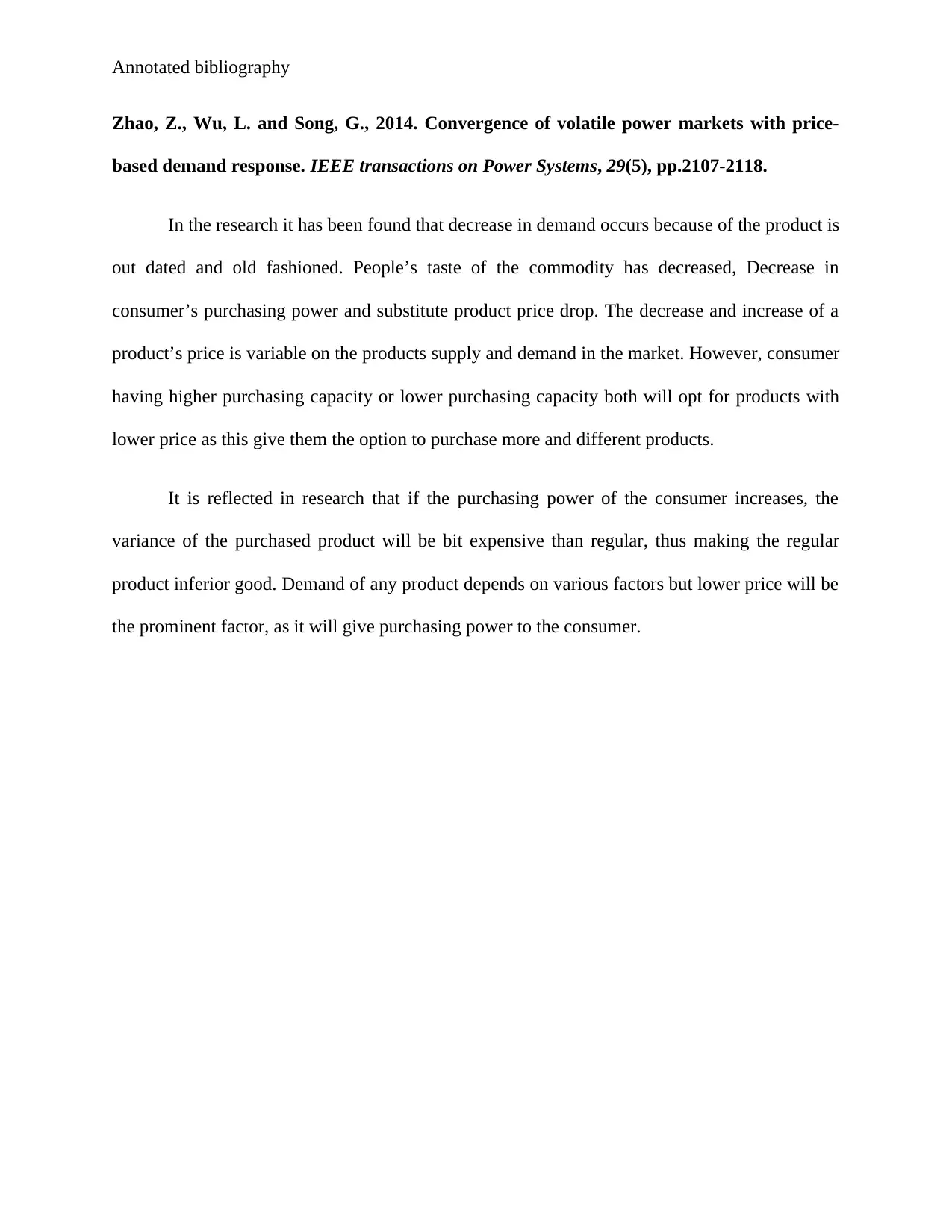
Annotated bibliography
Zhao, Z., Wu, L. and Song, G., 2014. Convergence of volatile power markets with price-
based demand response. IEEE transactions on Power Systems, 29(5), pp.2107-2118.
In the research it has been found that decrease in demand occurs because of the product is
out dated and old fashioned. People’s taste of the commodity has decreased, Decrease in
consumer’s purchasing power and substitute product price drop. The decrease and increase of a
product’s price is variable on the products supply and demand in the market. However, consumer
having higher purchasing capacity or lower purchasing capacity both will opt for products with
lower price as this give them the option to purchase more and different products.
It is reflected in research that if the purchasing power of the consumer increases, the
variance of the purchased product will be bit expensive than regular, thus making the regular
product inferior good. Demand of any product depends on various factors but lower price will be
the prominent factor, as it will give purchasing power to the consumer.
Zhao, Z., Wu, L. and Song, G., 2014. Convergence of volatile power markets with price-
based demand response. IEEE transactions on Power Systems, 29(5), pp.2107-2118.
In the research it has been found that decrease in demand occurs because of the product is
out dated and old fashioned. People’s taste of the commodity has decreased, Decrease in
consumer’s purchasing power and substitute product price drop. The decrease and increase of a
product’s price is variable on the products supply and demand in the market. However, consumer
having higher purchasing capacity or lower purchasing capacity both will opt for products with
lower price as this give them the option to purchase more and different products.
It is reflected in research that if the purchasing power of the consumer increases, the
variance of the purchased product will be bit expensive than regular, thus making the regular
product inferior good. Demand of any product depends on various factors but lower price will be
the prominent factor, as it will give purchasing power to the consumer.
Paraphrase This Document
Need a fresh take? Get an instant paraphrase of this document with our AI Paraphraser
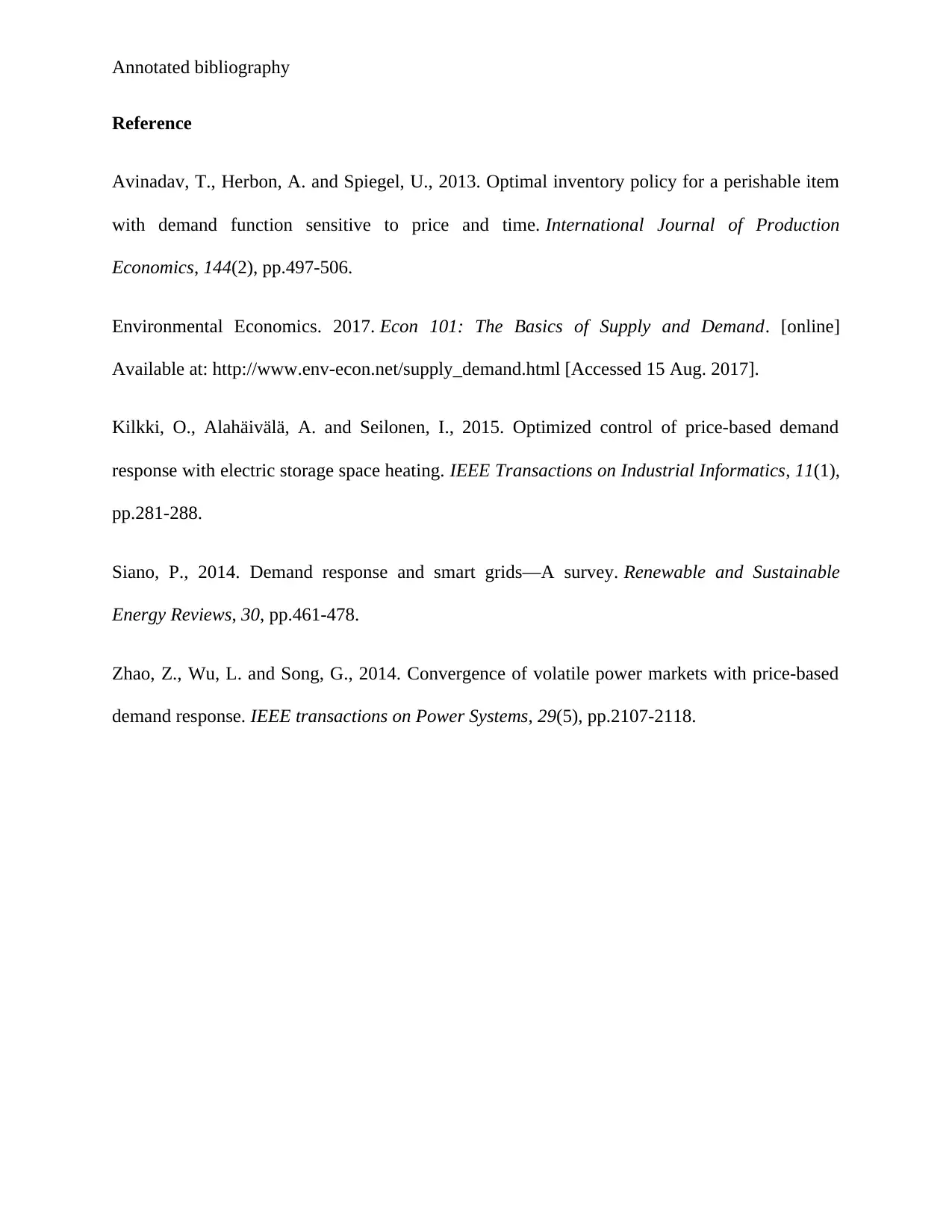
Annotated bibliography
Reference
Avinadav, T., Herbon, A. and Spiegel, U., 2013. Optimal inventory policy for a perishable item
with demand function sensitive to price and time. International Journal of Production
Economics, 144(2), pp.497-506.
Environmental Economics. 2017. Econ 101: The Basics of Supply and Demand. [online]
Available at: http://www.env-econ.net/supply_demand.html [Accessed 15 Aug. 2017].
Kilkki, O., Alahäivälä, A. and Seilonen, I., 2015. Optimized control of price-based demand
response with electric storage space heating. IEEE Transactions on Industrial Informatics, 11(1),
pp.281-288.
Siano, P., 2014. Demand response and smart grids—A survey. Renewable and Sustainable
Energy Reviews, 30, pp.461-478.
Zhao, Z., Wu, L. and Song, G., 2014. Convergence of volatile power markets with price-based
demand response. IEEE transactions on Power Systems, 29(5), pp.2107-2118.
Reference
Avinadav, T., Herbon, A. and Spiegel, U., 2013. Optimal inventory policy for a perishable item
with demand function sensitive to price and time. International Journal of Production
Economics, 144(2), pp.497-506.
Environmental Economics. 2017. Econ 101: The Basics of Supply and Demand. [online]
Available at: http://www.env-econ.net/supply_demand.html [Accessed 15 Aug. 2017].
Kilkki, O., Alahäivälä, A. and Seilonen, I., 2015. Optimized control of price-based demand
response with electric storage space heating. IEEE Transactions on Industrial Informatics, 11(1),
pp.281-288.
Siano, P., 2014. Demand response and smart grids—A survey. Renewable and Sustainable
Energy Reviews, 30, pp.461-478.
Zhao, Z., Wu, L. and Song, G., 2014. Convergence of volatile power markets with price-based
demand response. IEEE transactions on Power Systems, 29(5), pp.2107-2118.
1 out of 5
Related Documents
Your All-in-One AI-Powered Toolkit for Academic Success.
+13062052269
info@desklib.com
Available 24*7 on WhatsApp / Email
![[object Object]](/_next/static/media/star-bottom.7253800d.svg)
Unlock your academic potential
Copyright © 2020–2025 A2Z Services. All Rights Reserved. Developed and managed by ZUCOL.





